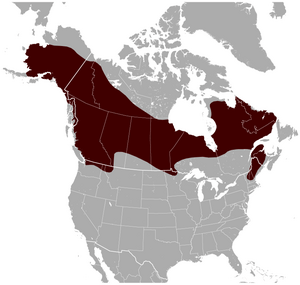Northern bog lemming facts for kids
Quick facts for kids Northern bog lemming |
|
|---|---|
| Conservation status | |
| Scientific classification | |
| Genus: |
Synaptomys
|
| Species: |
borealis
|
 |
|
| Northern Bog Lemming range | |
The northern bog lemming (Synaptomys borealis) is a small North American lemming. It is one of two types of lemmings in the Synaptomys family. The other one is called the southern bog lemming. These tiny animals live in cold, wet places across North America.
Contents
What They Look Like
Northern bog lemmings have bodies shaped like cylinders. They are covered in long, soft fur that is usually grey or brown. Their bellies are a lighter grey color. You might notice a small patch of rusty-colored hair right behind their ears.
These lemmings have small eyes and a snout that is quite hairy. Their tails are short, only about 2 cm long. They have 16 teeth in total. A cool fact about them is that their top front teeth (incisors) have a special groove. An adult lemming is usually about 13 cm long and weighs around 30 g. That's about as much as a small candy bar!
Where They Live and What They Eat
You can find northern bog lemmings in many wet, cold places. They live in northern forests, bogs (which are like wet, spongy wetlands), and tundra (a treeless, frozen plain). They also live in meadows across Canada, Alaska, northern Washington, and New England.
These lemmings mostly eat plants. Their diet includes grasses, sedges, and other green plants. They also munch on mosses. Sometimes, they even eat small creatures like snails and slugs. If you ever see their droppings, you might notice they are green!
Reproduction and Life Cycle
Female northern bog lemmings can have babies two or three times each year. Each time, they usually have four to six young. The baby lemmings are born in a special nest. This nest might be hidden inside a burrow they dug. Or it could be tucked away safely in thick plants.
How They Behave
Northern bog lemmings are busy animals all year long. They are active both day and night, even in winter. They create little paths, called runways, through the plants on the ground. They also dig burrows under the soil. In winter, they dig tunnels under the snow to stay safe and warm.
These lemmings often live together in small groups. Their numbers can change a lot over time. Lemming populations usually go through a cycle. Their numbers grow very large for a few years, then drop down again. This cycle usually takes about three or four years.


